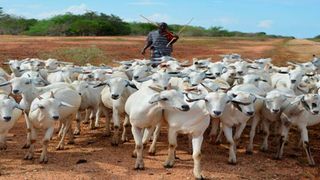
A herder with Galla goats at the ADC Galana Ranch in Kilifi County in 2017.
| File | Nation Media GroupSeeds of Gold
Premium
Demystifying the animal export process
I received many questions on last week’s article, which explained why it is wasteful to export live animals. Many people wanted to understand why exporting livestock requires military precision in logistics organisation.
I have said many times that the livestock farming system in Kenya has to change from subsistence to commercial for the country to effectively feed its citizens and trade profitably with other nations. That calls for a highly structured operation beyond just keeping animals.
There are nations in parts of the world like the Middle East and islands like Mauritius that will always find it economical to buy meat and other animal-based foods because of limitations in land size, environmental conditions and population growth. The Middle Eastern nations have lots of land but most of it is agriculturally unproductive desert with poor availability of ground water. They, therefore, have to source animal-based foods from other more endowed nations.
So let us look at the process and rigours of carrying out a livestock export operation in deeper details for an export to Oman for instance. The first thing is to establish a trade relationship between a Kenyan exporter and an importer in Oman. We shall consider export of goats.
The importer will want to know how much it costs for one healthy goat to land in Oman. That may sound an easy question but it calls for a very long process for the exporter to account for the total cost of identifying a goat in Kenya and moving it safely in good health and body condition to Oman. The supply process may take three to six months or more depending on the availability of suitable goats.
Importers will normally specify the characteristics of the goats they want depending on the market demand. In most cases, the goats are classified by breed, age and weight. All must be in good body condition to give quality meat.
The most suitable goats for export in Kenya are the Galla because they are the commonest, are available in large numbers in the North Eastern rangelands and they are fast growers. Most importers will require goats with a live body weight of 15-20kg, 20-25kg, 25-30kg and 40-60kg.
The weight ranges may be mixed and stated in percentages out of the total number ordered. That makes mixed weight supply order difficult to service because these are live animals and they are growing throughout the process of supplying an order. The weight range of 40-60kg is the easiest to deal with because this weight change is low and slow.
Once the type and number of goats ordered is agreed on, the importer obtains an import permit that gives the veterinary conditions required by the country of import. The import permit is a request from the importing country to the exporting country to be given a government guarantee that the goats being exported shall be as agreed between the trading parties and that they shall be free of specified diseases and also protected through vaccination against specified diseases.
The import permit allows the country of origin of the goats to carry out all the tests requested, confirm vaccination and then issue an export permit. The export permit is a commitment from the country of origin that the government has ensured all the requirements of the import permit have been fulfilled.
Oman will usually request that goats from Kenya are vaccinated against viral diseases like PPR, goat pox and foot and mouth. The goats must also be tested to confirm they are free of Rift Valley Fever and brucellosis.
All animals are tested when few, but for large numbers, a proportion representing the whole consignment is tested. The testing is done by officers from the veterinary directorate. Animals must also be confirmed to be free of both external and internal parasites such as ticks, mites, lice and worms.
Once the exporter is confident that they can fulfil the conditions of the import permit, she then scales the country side in the appropriate regions to identify and acquire the animals from farmers. The goats are identified and tagged, aggregated and transported to a holding ground where they are cleansed of all parasites and diseases.
Taita Taveta is a suitable holding area for export animals and it has been used for cattle, camels, sheep and goats. The government is also building the export quarantine facility for livestock at Bachuma in the county.
The export goats in holding area require security, feed, herding, shelter, water and veterinary care, in addition to the rented holding ground. Holding should be maintained at the minimum time allowable, of about 30 days, to minimise the cost of the operation.
Health certification of the goats is done at least 48 hours before they are transported to the dock in Mombasa for shipment. Specially designed livestock transport vessels are used to transport the animals to the importing country. During sea transport, the animals are provided with feed, water and veterinary care like happened during holding.
The major costs in food animal export are livestock screening and identification, purchase, transport overland and by sea, holding and overall health certification. It is only after understanding and determining the total cost of executing the export operation that an exporter can load her profit margin and then be able to state the cost of landing one goat in Oman from Kenya. The cost will vary based on the efficiency of the export operation.





